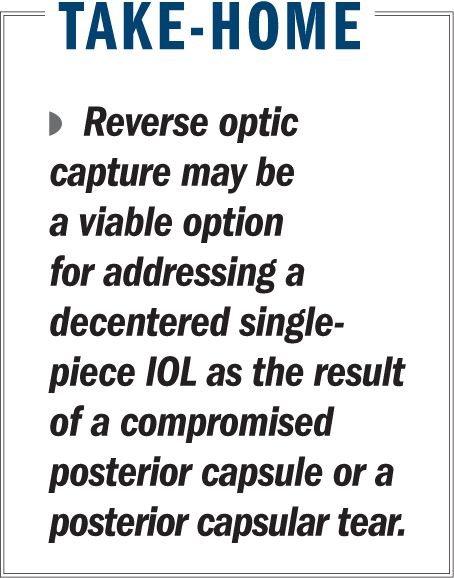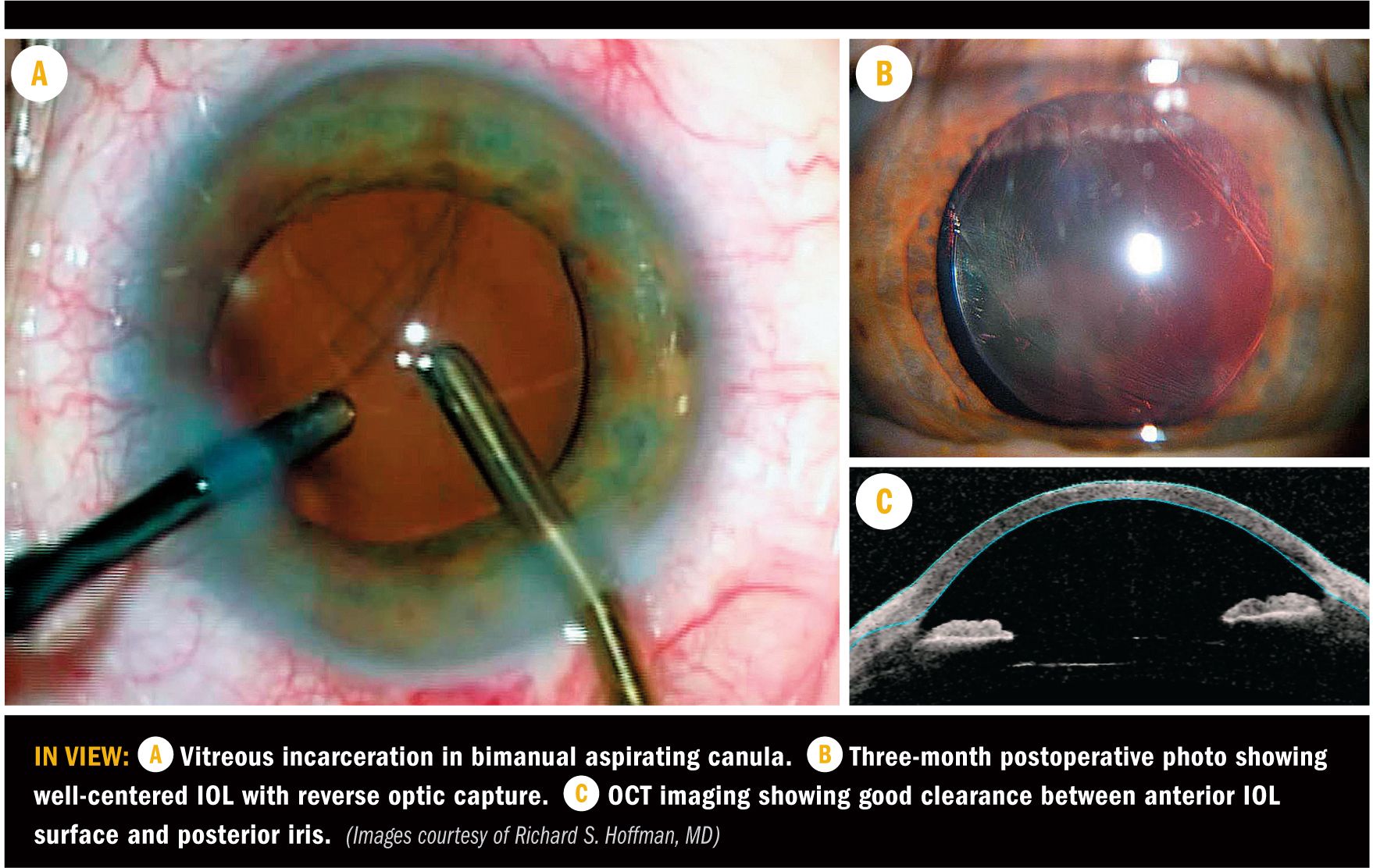Article
Reverse optic capture effective for posterior capsule tears
Reverse optic capture may be a viable option for addressing a decentered single-piece IOL as the result of a compromised posterior capsular or a posterior capsular tear.
Reviewed by Richard S. Hoffman, MD
Eugene, OR–All surgeons, no matter how experienced, encounter tough cases that require creative approaches.

Richard Hoffman, MD, described such a patient with a 2+ nuclear sclerotic cataract that he removed using a standard bimanual technique, which progressed routinely.
Sponsored: Join us for dinner and discussion at AAO in Chicago!
Dr. Hoffman used a horizontal chopping technique to remove the nucleus and filled the capsular bag with a cohesive viscoelastic (OVD). The anterior capsulorhexis and posterior capsule were intact.
Dr. Hoffman, clinical associate professor of ophthalmology, Oregon Health & Science University, Eugene, OR, injected a single-piece hydrophobic acrylic IOL into the bag. The haptics were covered with polymethylmethacrylate mittens to prevent them form sticking to the optic.
Recent: What social media was buzzing about at ASCRS 2016
During the centering of the IOL, a crease in the posterior capsule was visible. Dr. Hoffman hypothesized that it was a zonular dialysis with a wrinkled bag that might resolve with gentle pushing down on the IOL. Repeated pushing did not reach the desired end.
Since the lens was centered, Dr. Hoffman started to remove the OVD. In doing so, the IOL began to shimmy and vitreous was visible in the aspirating cannula. The IOL appeared slightly tilted and moved down toward what Dr. Hoffman described as an obvious opening in the equator of the bag.
Related: Intraoperative aberrometry providing ‘tighter’ outcomes
Surgical options
Surgical options
The surgical options for a torn posterior are:
- Leave the IOL in place and address it if it subluxates further;
- Levitate the IOL into the ciliary sulcus (not an option for a single-piece IOL);
- Levitate the IOL into the ciliary sulcus and suture the haptics (also not a viable option);
- Use the capsulorhexis to capture the optic;
- Exchange the IOL for a three-piece IOL in the sulcus
Dr. Hoffman opted to perform a reverse optic capture. He first injected an OVD in front of the lens and more behind the lens to push the vitreous back behind the capsule. He then used the same viscoelastic cannula to prolapse the optic up in front of the anterior rhexis, which proved to be successful.
“At this point, the IOL was centered and stable,” Dr. Hoffman commented.
Recent: Femtosecond laser or manual cataract removal for accommodating IOLs?
Because vitreous was in the anterior chamber previously, Dr. Hoffman removed the OVD using a 23-gauge vitrector. A 20-gauge irrigating cannula was positioned through the left-hand incision. Hindsight suggested that a 20-gauge vitrector would have prevented fluid from egressing from the bimanual incision.
After removing as much of the OVD as possible, Dr. Hoffman removed the vitrector and kept the irrigator in the eye. He injected triamcinolone to identify any vitreous in the anterior chamber, and used the irrigator to wash the triamcinolone out of the eye.
No vitreous in anterior chamber

When no vitreous was seen in the anterior chamber, Dr. Hoffman hydrated the incision and kept the irrigator in the eye to maintain the pressure and prevent vitreous from coming from around the lens.
“The reality was that with the optic captured on the rhexis, even if the chamber did become shallow, additional vitreous probably would not have come forward,” Dr. Hoffman said.
Related: Combination of NSAIDs and steroids reduces CME outcomes
He finished the surgery by hydrating the wounds, removing the infusing cannula, and injecting Miochol-E (acetylcholine, Bausch & Lomb) into the anterior chamber.
Three months postoperatively, the IOL remained centered. OCT showed good clearance between the anterior surface of the IOL and the posterior surface of the iris.
Considerations
Considerations
Dr. Hoffman noted that the Cataract Clinical Committee of the American Society of Cataract and Refractive Surgery has emphasized that single-piece IOLs should not be implanted into the ciliary sulcus without fixation because of the risk of pigment dispersion, glaucoma, uveitis, and recurrent vitreous hemorrhages.
Recent: How new ‘evolving’ IOL formula maximizes lens accuracy
“However, it may be OK to put single-piece IOLs in the bag and perform reverse optic capture,” said Dr. Hoffman, recounting a recent study of the procedure performed in 16 eyes, with 12 of the fellow eyes serving as controls (Ophthalmic Surg Lasers Imaging 2012;43:480-8).
The authors reported that patients achieved 20/25 or better vision in 94% of the eyes in which the reverse optic capture was performed compared to 92% in the control eyes. In both groups, 94% and 100%, respectively, were within 1 D of the intended correction. The IOLs in all eyes that underwent reverse optic capture remained centered, and no vision-threatening complications occurred after 19 months of follow-up.
Related: Laser cataract surgery continues to transform capsulotomies
The study concluded that reverse optic capture of a single-piece acrylic IOL through an anterior capsulorhexis merits consideration for IOL placement in selected cases of insufficient posterior capsule support.
More: View the top news recap from ARVO and ASCRS!
Richard Hoffman, MD
This article was adapted from a presentation Dr. Hoffman made at the 2015 American Academy of Ophthalmology meeting. He has no financial interest in any product mentioned in this report.
Newsletter
Don’t miss out—get Ophthalmology Times updates on the latest clinical advancements and expert interviews, straight to your inbox.






